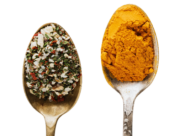A Tagine or Tajine is both the name of the dish and the glazed earthenware vessel in which the food is prepared in Morocco and Algeria. It is used for cooking and for serving. Nomads use it as portable ovens over charcoal braziers, called kanoun. A constant, low-level heat diffuses around the pot resulting in a gradual reduction of the liquid.
Tagine, the clay cooking pot, has two parts: the bottom plate with a high rim and a conical shaped lid with a knob on top. The knob enables the cover to be lifted without mittens. It remains cool to touch during the cooking process. The conical shape allows the condensation created during cooking to run down the sides of the cone constantly moisturizing the food on the bottom.
-02.jpg)
The glazed tagines are designed only as serving dishes (like mine in the photo). Unglazed tagines can be used for cooking over low heat only, they will break up at high heat. There are some “high-tech” tagines with a metal bottom allowing meat to be browned in it over high heat. Tagines must be washed by hand. When buying one, make sure you understand how to handle it. Traditional tagines come richly decorated and render a wonderful presentation to a dish and table.
Tagines, as a dish, fall into two groups, albeit the distinction has become blurred a bit in recent times. M’hammer are those dishes cooked with olive oil or butter and spiced with paprika and cumin. Those cooked in oil with saffron and ginger are called M’qualli.

-01.jpg)

